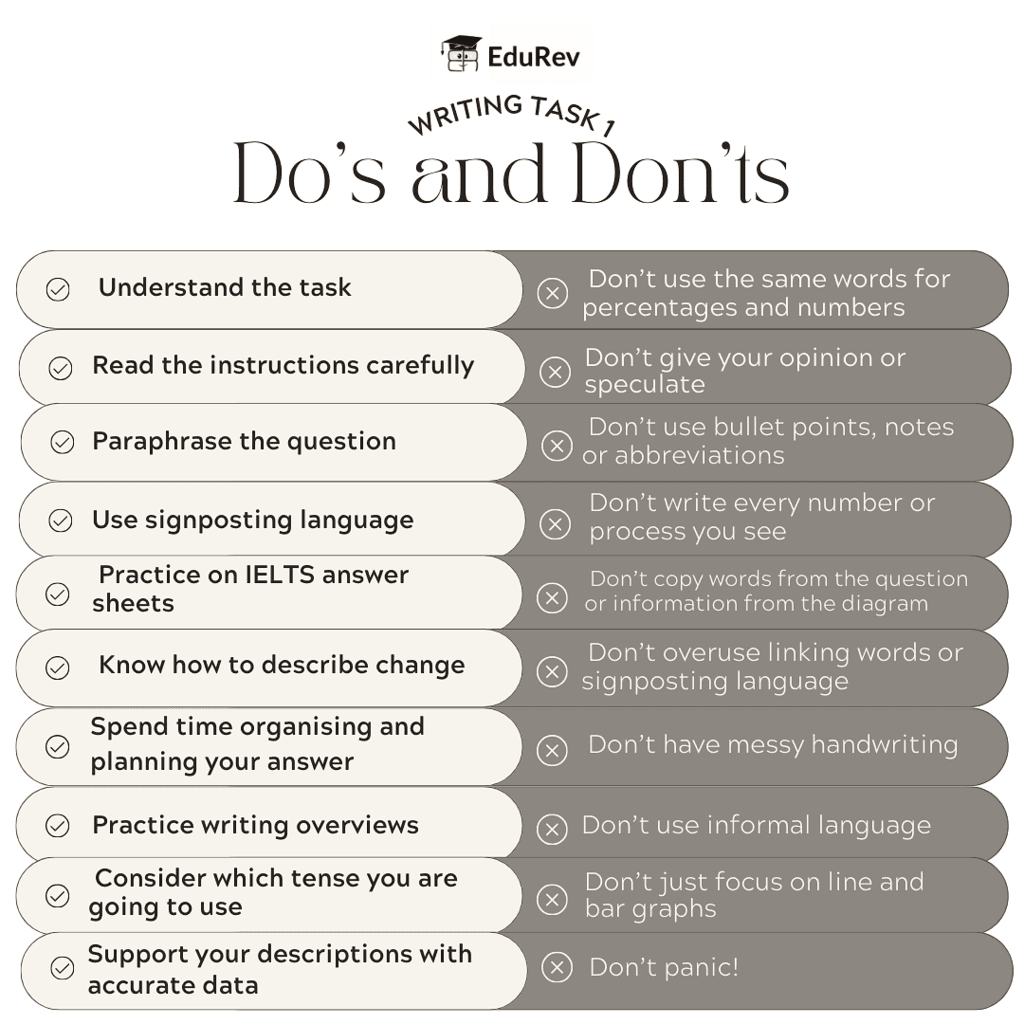Do's & Don'ts of Writing Task 1 | Writing for Academic IELTS PDF Download
Mastering IELTS Writing Task 1 might feel tough, but with smart preparation and knowing crucial tips, you can shine and elevate your overall IELTS score. This detailed guide is filled with vital advice, clear examples, and things to steer clear of. Dive in and enhance your IELTS journey!

DOs
1. Do understand the task
- Every IELTS academic writing task 1 will present you with some form of visual data. This could be a bar graph, line chart, pie chart, table, or diagram.
- Your first critical step is understanding what this data signifies.
2. Do read the instructions carefully.
- Although it may appear to be evident, failing to comprehend the question is one of the most frequent blunders made by IELTS writing task 1 candidates.
- It is advisable to take a minute to read the question multiple times and comprehend its requirements.
- Practising regularly can also aid in becoming acquainted with various task 1 question types, resulting in time-saving during the exam.
3. Do paraphrase the question.
- If you reproduce the words from the question in your response, you will receive a lower score, and the examiner is searching for evidence of your ability to rephrase the question.
- To paraphrase, substitute keywords with other synonyms to make it interesting.
Example:
Question: The graph below gives information about cinema attendance in the UK between 1998 and the present, with projections to 2018.
Paraphrased: The diagram shows data of movie-goers in the United Kingdom from 1998 until now, with forecasts up to 2018. As you can see, the meaning has not changed but the words have. This should be the first paragraph in your essay.
4. Do use signposting language.
- These are words and phrases that tell the examiner what you are writing about. They are sometimes also called ‘discourse markers’.
- Examples include ‘The graph/table/chart shows…’, ‘The most significant change is….’, ‘Another noticeable change/trend is….’, ‘Overall…’.
Remember that these should only be used appropriately.
5. Do practice on IELTS answer sheets.
- Numerous students are concerned about their inability to produce a minimum of 150 words in IELTS writing section 1.
- A smart strategy to monitor the word count is to practice using official examination answer sheets, enabling you to estimate the amount of space required for 150 words. You can effortlessly locate these sheets by conducting a rapid Google search.
 Task 1 Answer Sheet
Task 1 Answer Sheet
6. Do know how to describe change?
- You will pick up easy marks if you know how to accurately describe change. From very small to very large, here are some examples:
- Minimal-slight-gradual-moderate-considerable-significant-substantial-enormous-dramatic.
You will normally have to describe change in your task 1 essay and these more advanced words will help you gain some valuable marks for ‘lexical resource’.
7. Do spend time organising and planning your answer.
- Planning your response is a key factor that sets apart high-scoring and low-scoring candidates in IELTS writing. Taking the time to plan your answer is always beneficial as it results in a well-organized and lucid response, ultimately aiding in obtaining a higher score.
- Familiarise yourself with the different question types and then learn the different structures for each one. For example, a bar chart should look like this:
Paragraph 1- paraphrase question.
Paragraph 2- overview.
Paragraph 3- describe main feature in detail.
Paragraph 4- describe another main feature in detail.
When you have this structure in your head, you will be able to plan an effective answer quickly and easily.
8. Practice writing overviews.
- Crafting a strong overview is perhaps the most crucial paragraph in your entire essay. By creating a well-written overview, you are on the right track to achieving a good band score. An overview essentially summarizes the primary features exhibited in the diagram.
- To create an effective overview, you must identify the primary trends depicted in the diagram, such as growth, decline, or fluctuation.
- For processes, determine the number of primary stages, significant changes and outcomes. It's important to note that your overview should not contain numerical figures; instead, describe the most notable aspects in general terms, with the details presented in subsequent paragraphs.
9. Do consider which tense you are going to use.
Many IELTS candidates lose easy marks by only writing in the present tense. Ask yourself if any of the data is about the past or the future and change your tenses accordingly.
10. Support your descriptions with accurate data.
As previously mentioned, avoid using numerical figures in the overview section. However, you will need to incorporate data to explain the primary features in subsequent paragraphs. It is critical to select the appropriate data and ensure its accuracy.
DONTs
1. Don’t use the same words for percentages and numbers.
- For percentages use words like large/small/higher/lower percentage of…
- For numbers use words like many/more/most/few and fewer.
2. Don’t give your opinion or speculate.
- It's important to note that IELTS task 1 is not a discursive essay; that is reserved for task 2. It is essential to write precisely what is presented and avoid providing rationales for the data, unless explicitly instructed in the diagram.
- Failure to adhere to this may result in a significant loss of marks. Additionally, refrain from adding new information or drawing any conclusions based on the data depicted.
- For instance, a student who is an engineer was presented with a diagram outlining how a car engine operates. Using his extensive knowledge, he wrote a highly detailed description of the process.
- Despite the accuracy of his information, it was not displayed in the diagram. As a result, he did not achieve the expected score due to this mistake.
3. Don’t use bullet points, notes or abbreviations.
Again, this might be fine in university essays but not in IELTS essays.
4. Don’t write every number or process you see.
- Several students make this mistake and end up dedicating excessive time to task 1. Keep in mind that you are only required to write about the most prominent features.
- For instance, in a line graph or bar chart inquiry, you will only need to address two or three aspects. Writing about additional elements is pointless and will not earn you extra marks.
5. Don’t copy words from the question or information from the diagram.
- If you do this examiners will not mark these words and it is therefore like writing nothing at all.
- To overcome this, familiarize yourself with the common vocabulary used in IELTS writing part 1 and learn synonyms for this information. Also, use synonyms when practicing writing.
6. Don’t overuse linking words or signposting language.
- As suggested above, it is recommended to use certain linking words. However, some students make the mistake of memorizing too many of them and using them excessively to impress the examiner. Sadly, such students end up losing marks for overusing linking words.
- To avoid this problem, it is advisable to use about six of these words and phrases. Using more than eight may seem like you are trying too hard to insert them, without paying attention to whether they are appropriate or not.
7. Don’t have messy handwriting.
- In IELTS writing, it's crucial to have neat and legible handwriting. If your handwriting is difficult to read, the examiner won't be able to give you marks for the words they can't decipher.
- As we're more reliant on typing and computers these days, it's essential to assess the readability of your handwriting.
- You can seek feedback from a teacher or friend by showing them your practice tests to determine if your handwriting is clear and easy to read.
8. Don’t use informal language.
Remember this is an academic essay and you are expected to write in that style. Avoid phrasal verbs, slang and colloquial language.
9. Don’t just focus on line and bar graphs.
- These may have been popular in the past but it doesn’t mean IELTS will continue to use them that often. We are seeing many more maps, pie charts and process diagrams these days.
- Many students overlook these kinds of questions and if you are well prepared for every type of question you will really stand out from the crowd.
10. Don’t panic!
Many students open up the exam paper, see something they know nothing about and then panic.
Conquering the IELTS academic writing task 1 is more achievable than it seems initially. Grasp the task, master paraphrasing, create a concise overview, elaborate on paragraphs, use academic language, stick to the word limit, and manage your time wisely. Following these steps ensures a confident journey toward success. Remember, consistent practice and reflection are your most potent allies.
|
30 videos|206 docs|17 tests
|
FAQs on Do's & Don'ts of Writing Task 1 - Writing for Academic IELTS
| 1. What is the purpose of Task 1 in the IELTS exam? |  |
| 2. How should I structure my response in Task 1 of the IELTS Writing section? |  |
| 3. Are there any specific vocabulary or language techniques that I should use in Task 1? |  |
| 4. How long should my response be in Task 1 of the IELTS exam? |  |
| 5. Can I use bullet points or abbreviations in Task 1 of the IELTS Writing section? |  |






















